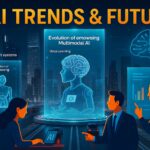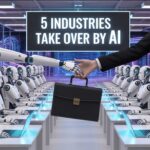Artificial Intelligence (AI) is no longer just a futuristic concept; it’s the reality behind some of the biggest companies in the world today.
By automating routine tasks to making more informed decisions, AI is reinventing the way businesses operate more efficiently and grow.
If we’re speaking of AI in business and productivity, it’s not just about automating. It’s about using intelligent tools to save time, reduce costs, and create new opportunities.
It could be chatbots to enhance customer service, predictive analytics driving inventory, and an AI-based machine spotting fraud; the possibilities are endless.
AI doesn’t just speed up work; it also makes it smarter. Productivity today is no longer solely a function of the number of hours we work, but of how effectively businesses are able to scale, adapt and innovate using AI.
This guide will explore the evolution, benefits, tools, applications, risks, and future of AI in business, giving you a clear roadmap to harness AI for growth and sustainable success.
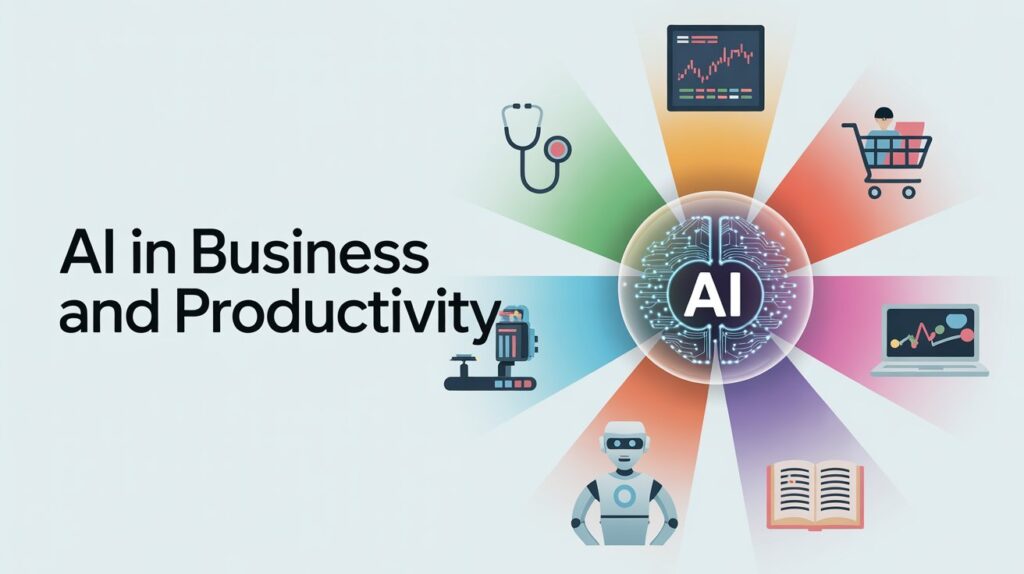
Why AI in Business and Productivity is Not Just a Buzzword but a Growth Driver?
AI was no longer a buzzword for technology giants; it was a true driver of business growth. AI is now used by businesses of all sizes to trim expenses, improve efficiency and open new sources of revenue.
- From hype to results: What was once considered futuristic, AI now underpins chatbots, predictive analytics and smart automation in everyday business.
- Productivity gains: Services that have tended to run manually include data entry, customer queries and the scheduling of tasks; meanwhile, leadership groups get faster, data-based insights.
- New opportunities: Personalized marketing, faster product innovation, and multilingual support expand markets.
- Competitive edge: Companies leveraging AI provide superior experiences and operate more efficiently at a lower cost, which is simply unprecedented against traditional competition.
With proven outcomes (like Netflix saves 1B per year by making recommendations), we’ve seen from it, we can say definitively that AI is more than a buzzword. It’s a strategic growth driver.
Evolution of AI in Business
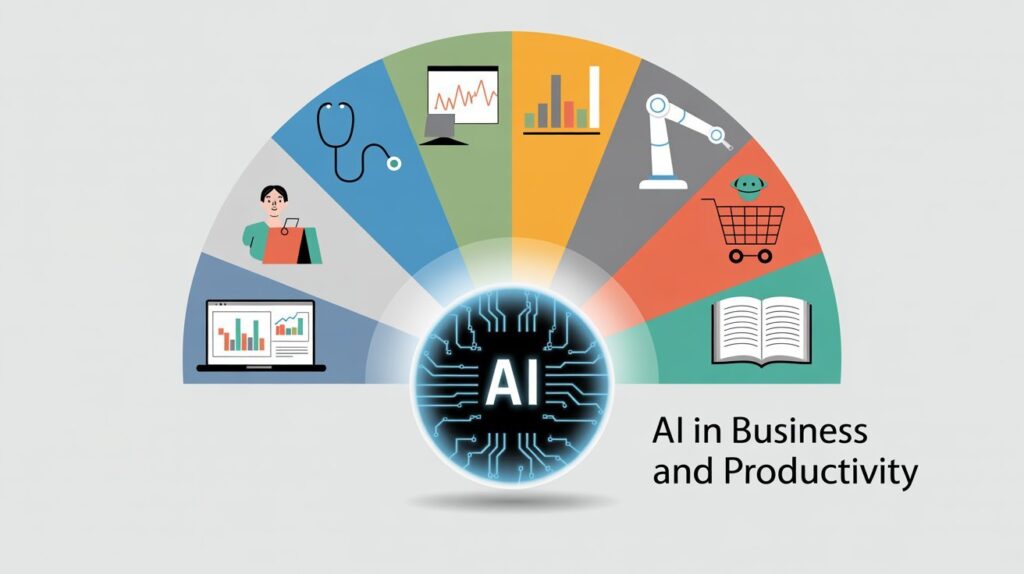
The journey of AI in business and productivity has been nothing short of revolutionary. What began as basic automation has evolved into a primary driver for decision-making, strategy and innovation.
1. Early Stages: Automation & Simple Analytics
When humans first adopted AI, it was mostly for rule-based systems and automations. Businesses used it mainly for:
- Data entry & reporting – automating repetitive clerical tasks.
- Basic analytics – spotting patterns in structured data like sales trends.
- Workflow automation – streamlining routine processes such as payroll or inventory management.
This early AI was time-saving, but it was still limited in scope; it was more about efficiency than intelligence.
2. Present: AI-Driven Decision-Making & Predictive Analysis
Today, AI is a strategic partner for businesses. Organizations leverage sophisticated tools such as machine learning, natural language processing (NLP) and computer vision to:
- Predictive analysis: forecasting demand, customer behavior, and risks.
- AI-powered decision-making: using data insights to guide marketing, operations, and product development.
- Personalization: tailoring customer experiences in e-commerce, banking, and healthcare.
- Chatbots & virtual assistants: handling millions of queries instantly, improving both customer satisfaction and productivity.
For example, Amazon uses AI-powered forecasting to streamline supply chains, and banks use AI for fraud detection.
3. Future Outlook: AGI and Industry Transformation
The future holds Artificial General Intelligence (AGI), AI systems that are capable of reasoning like humans across various sectors. We’re not there yet, but some of the trends to watch include:
- Hyper-automation is the application of advanced technologies, including artificial intelligence (AI) and machine learning (ML), to increasingly automate processes and augment humans.
- Smarter decision ecosystems – AI and executives coll a b or ating to drive long-term strategy.
- Industry reinvention – healthcare through AI-based diagnostics, retail through hyper-personalization, and manufacturing via self-optimizing factories.
In the coming years, AI will not just help businesses; it will fundamentally change industries and define the future of productivity.
What Are The Core Benefits of AI in Business and Productivity?
AI isn’t just a tech upgrade; it’s a strategic lever of growth. PwC1 estimates that AI will contribute $15.7 trillion to the global economy by 2030, underlining its potential power as a tool for business transformation.
Businesses that adopt AI can realize tangible gains in efficiency and quality of decisions, as well as customer experience.
1. Efficiency & Cost Reduction
By automating routine tasks, AI simplifies processes, preventing errors and cutting the cost of labor.
- Example: In manufacturing, AI-powered robots power assembly lines with accuracy, reducing downtime by as much as 20–30%.
- Stat: McKinsey reports that AI has the potential to slash supply chain forecasting errors by 50%, saving a lot of money.
- Business impact: Companies save millions every year with more output with fewer resources.
2. Data-Driven Decision Making
Raw data is converted into actionable insight through AI. Businesses can better inform decisions more quickly, whether it’s predicting market turns or uncovering patterns in customer behaviors.
- Example: Financial institutions/Banks are using AI to analyze real-time market data, which allows traders to minimize their risks and maximize their profits.
- Stat: According to Gartner, 70% of organizations will soon change their reliance on statistics-based data reporting in 2025, and move to decision-making that is algorithm-based.
- Business impact: Things like evidence-based strategies to reduce the guesswork, increase accuracy and competitive edge.
3. Personalization at Scale
AI helps companies provide a tailored experience for millions of people at the same time.
- Example: Netflix guesses what you want to watch with a 75% success rate, and 35% of Amazon’s revenue is because of its powerful AI recommendations.
- Stat: According to Salesforce, 66% of consumers expect companies to understand their unique needs, and AI makes this possible.
- Business impact: Increased engagement, stronger brand loyalty, and higher customer lifetime value.
4. Enhancing Creativity and Innovation
AI isn’t replacing creativity, it’s multiplying it. Product design, marketing campaigns and even R&D can now be supported with generative AI tools.
- Example: Coca-Cola turned to concepts from AI for ad campaigns and fused human creativity with the insights of the machines.
- Stat: According to a Deloitte poll, some 61% of executives think AI facilitates faster innovation among their teams.
- Business impact: Accelerated innovation cycles and the ability to experiment with new ideas at lower risk.
Key Applications of AI in Business and Productivity Across Industries
AI in business and productivity refers to the use of artificial intelligence to automate processes, improve efficiency, and support better decision-making across industries. Here are some of the most transformative applications:
1. AI in Healthcare
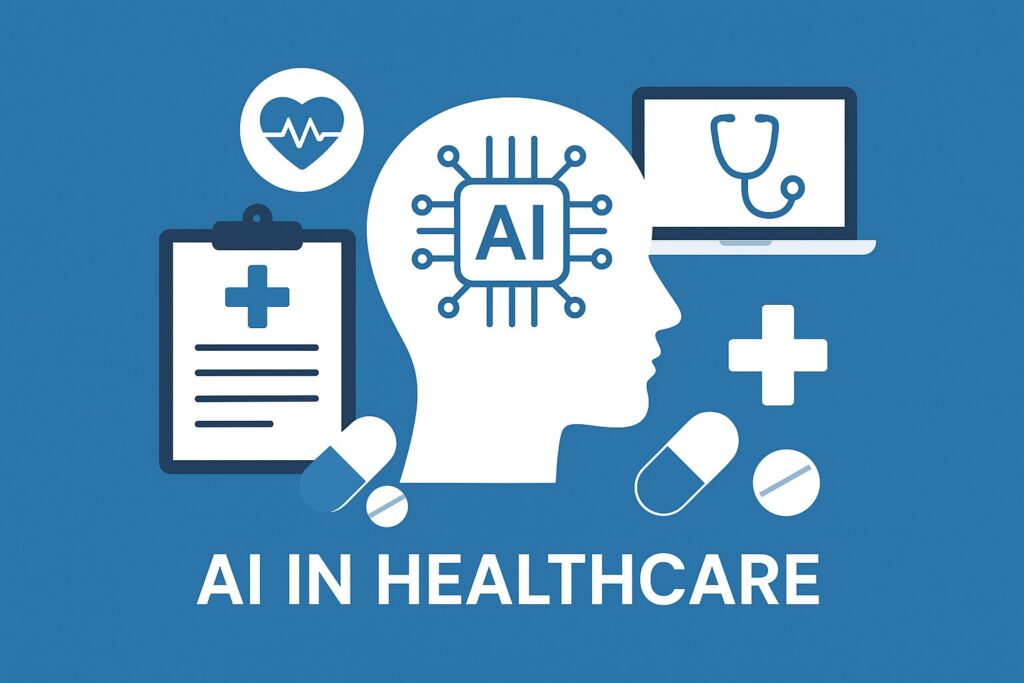
AI is revolutionizing patient care, diagnostics, and medical research.
- Predictive Diagnosis: Machine learning models catch diseases like cancer sooner than do traditional methods.
- Drug Discovery: AI brings down cost and speed in R&D, analyzing trillions of molecular interactions in a matter of weeks, not years.
- Personalized Treatment: Algorithms create patient-specific treatment plans.
Stat: According to Accenture, AI could save the U.S. healthcare economy $150 billion annually by 2026.
Example: IBM Watson helps doctors diagnose rare diseases by sorting through enormous medical databases.
2. AI in Finance
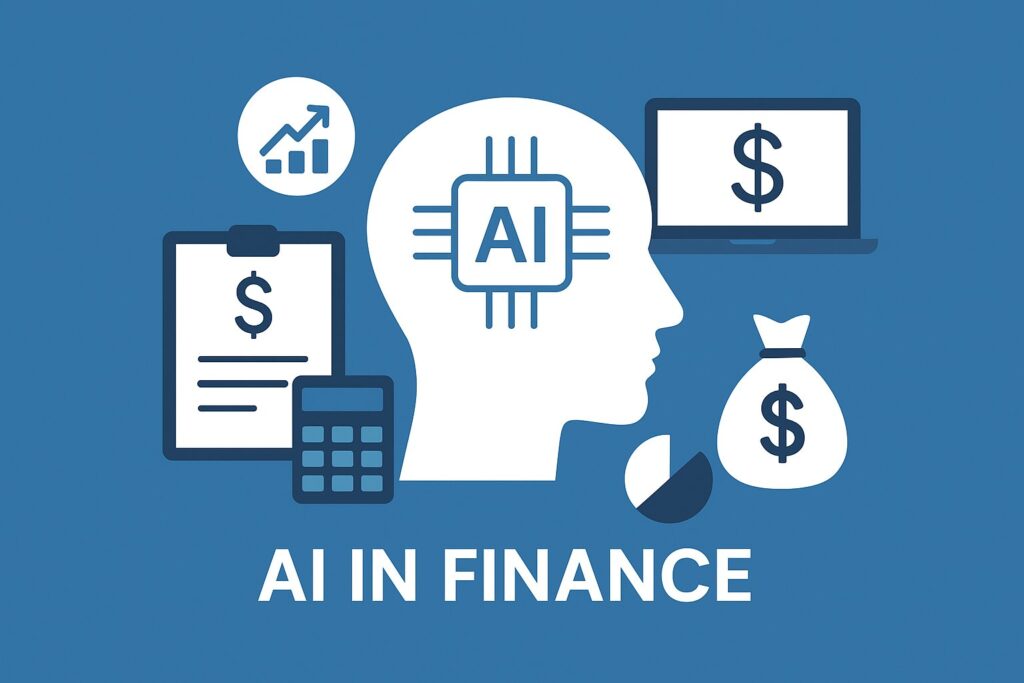
Banks, financial startups, and investment companies uses AI in data analysis, risk analysis, decision-making, and customer service.
- Fraud Detection: AI identifies unusual spending patterns to prevent fraud.
- Robo-Advisors: Platforms like Betterment and Wealthfront offer AI-powered investment advice.
- Credit Scoring: AI considers non-traditional data (like online behavior) for more accurate risk assessment.
Stat: Juniper Research projects that AI will save banks $447 billion by 2023, thanks to automation and risk management.
Example: JPMorgan Chase uses latest AI trends to review commercial loan contracts, reducing the time from 360,000 hours to seconds.
3. AI in Retail & Ecommerce
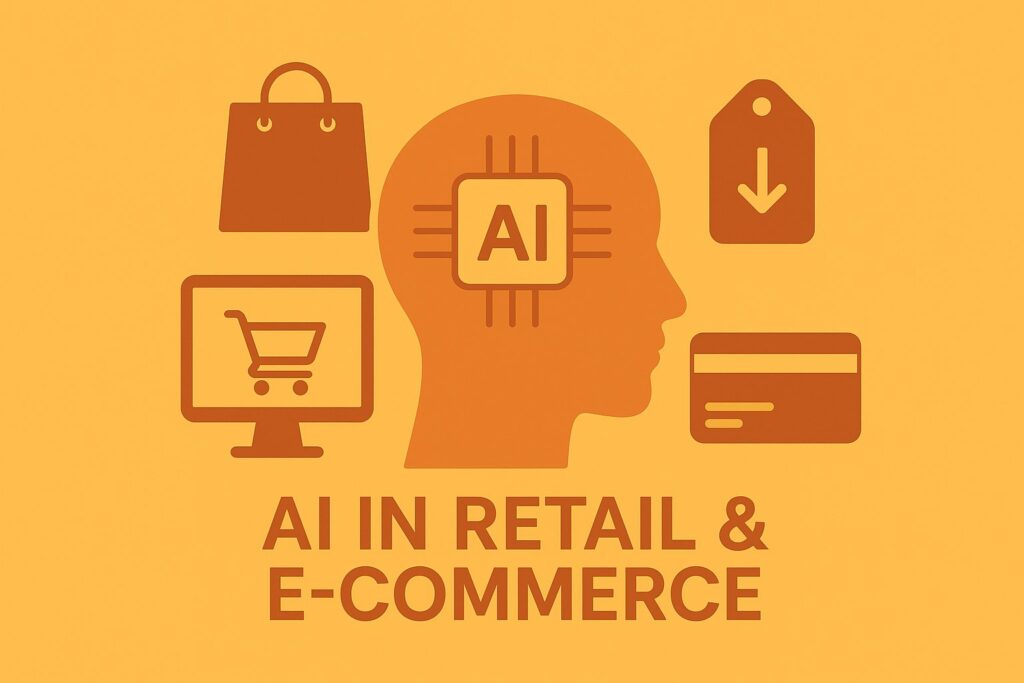
AI is being used by retailers to customize shopping experiences, price more efficiently and manage inventory.
- Personalized Recommendations: AI-driven product recommendations account for 35 % of Amazon’s revenue.
- Dynamic Pricing: Retailers change prices all the time, based on demand and competition.
- Smart Inventory: Predictive analytics prevent overstocking and shortages.
Stat: Salesforce discovered that 76% of customers demand personalized interactions, and AI enables just that on a mass scale.
Example: Walmart uses new AI tools for real-time shelf management and forecasting demand.
4. AI in Manufacturing
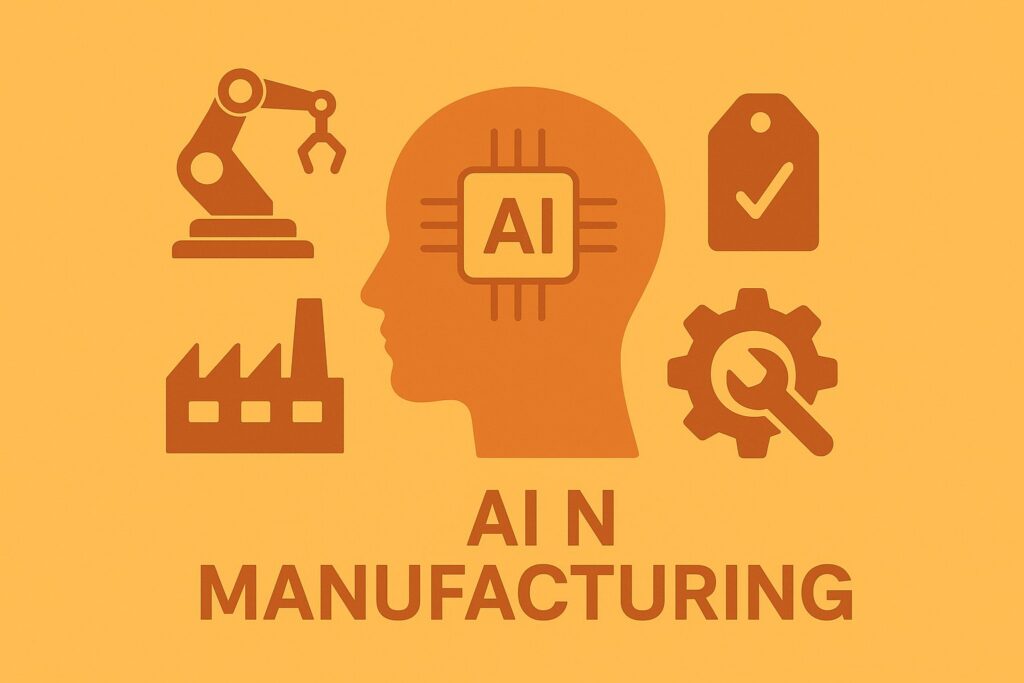
AI drives efficiency, predictive maintenance and automation in smart factories.
- Predictive Maintenance: AI detects equipment failures before they happen, reducing downtime.
- Supply Chain Optimization: AI improves demand forecasting and logistics planning.
- Quality Control: Computer vision programs can look at products more quickly and accurately than humans.
Stat: McKinsey calculates that AI could potentially boost global manufacturing productivity by 20%.
Example: Siemens is implementing AI in its factories’ production lines to improve efficiency and cut waste.
5. AI in Marketing & Sales
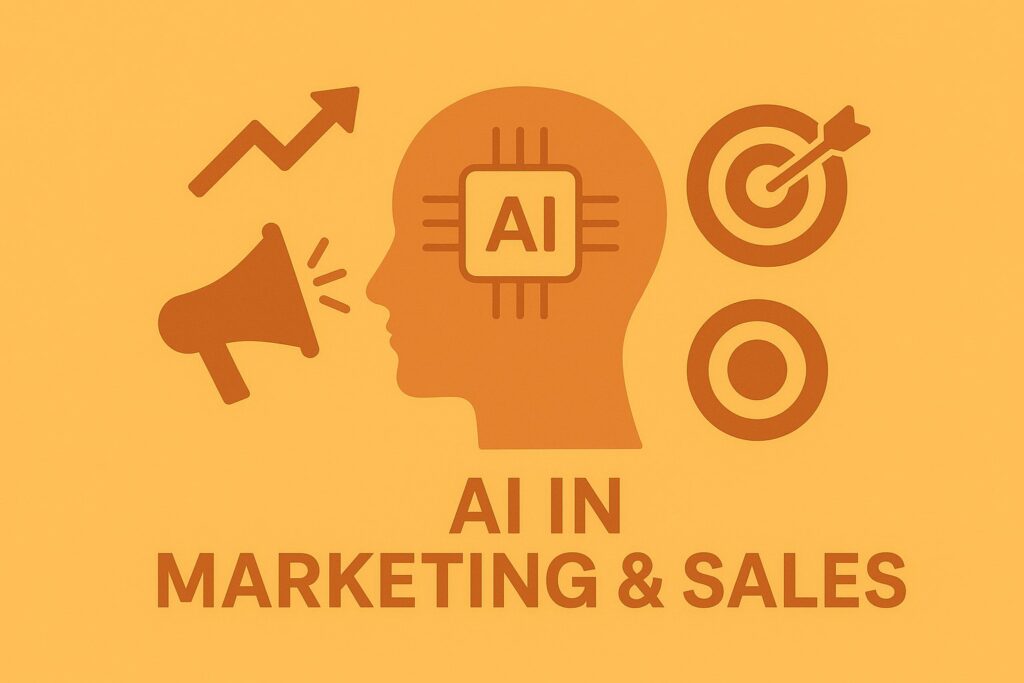
Marketers leverage AI for better targeting, engagement, and customer insights. Nowadays, campanies, uses AI tools for filling sales data spreadsheets. This help them to easy their work and minimize the work load on sales person.
- Customer Segmentation: AI analyzes demographics, behavior, and interests.
- Predictive Analytics: Helps forecast consumer demand and campaign success.
- Chatbots & Virtual Assistants: Provide 24/7 customer support.
Stat: HubSpot says 40% of businesses see increased spending on marketing automation as a direct result of AI implementation.
Example: Coca-Cola uses AI insights to build personalized ad campaigns all around the world.
6. AI in Education
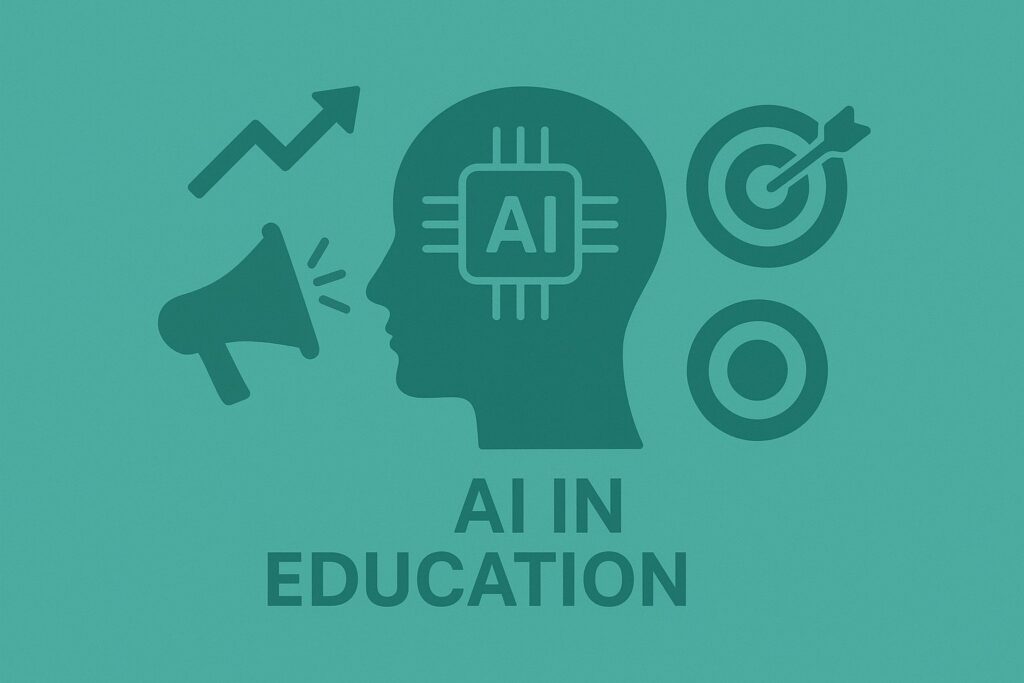
AI personalizes learning and improves access to education.
- Adaptive Learning: AI platforms adjust content difficulty based on student progress.
- Automated Grading: Saves teachers time by grading assignments.
- Virtual Tutors: Provide students with round-the-clock support.
Stat: HolonIQ expects that the AI in education will become a $25 billion market by 2030.
Example: Duolingo allows user-specific language learning paths to be personalized by means of AI. In a similar way, AI tools are also being used for resume writing, helping students and job seekers present their skills more effectively.
Challenges and Risks of Implementing AI in Business
Business and productivity AI present huge opportunities, but with them, some significant challenges that need to be addressed by companies for success.
1. High Implementation Costs
AI requires massive upfront investments in cloud infrastructure, machine learning platforms, and skilled professionals.
- Case Study – JP Morgan Chase:
- $9-12 billion per year on tech, of which a chunk goes to AI (trading automation, fraud detection, compliance).
- Outcome: AI-enabled JP Morgan to bring down the manual document review time from 360,000 hours per year to a few seconds using their COIN (Contract Intelligence) platform.
- Risk: Smaller banks simply can’t compete with this level of investment, and that has the potential to create a digital divide in banking.
- Stat: A 2022 PwC study found that 63% of companies have a hard time justifying AI ROI given the big upfront costs.
Takeaway: Use scalable AI solutions (Cloud AI, SaaS tools) to eliminate huge upfront costs that come with investing in AI.
2. Data Privacy & Security Concerns
Artificial intelligence depends on huge data sets, which raises questions of misuse and exploitation.
- Case Study – Facebook–Cambridge Analytica (2018):
- The data of 87 million users was harvested without consent and used in political profiling.
- Outcome: Facebook was staring down a $5 billion fine from the F.T.C., among the largest in the agency’s history.
- Risk: If they are not regulated well, AI-enabled personalized systems may breach the user’s privacy in an inadvertent manner.
- Stat: IBM’s Cost of a Data Breach Report 2023 revealed that the worldwide average cost of a breach increased to $4.45 million, a 15% increase in 3 years.
Takeaway: Businesses have to implement big data governance, anonymization and stay compliant with regulations (GDPR, DPDP Act).
3. Bias in AI Algorithms
Bias comes from skewed or incomplete training data.
- Case Study – Amazon’s AI Hiring Tool:
- Trained on 10 years of resumes (most of them from men in tech), the system docked the resumes of applicants mentioning “women’s” (such as “women’s chess captain”).
- Outcome: Amazon tossed the tool in 2017 when company officials realized it couldn’t be patented and could perpetuate bias on the job.
- Risk: Bias is also the kind of thing that can get you sued for discrimination and wreck your reputation.
- Stat: A 2022 McKinsey study found that 45% of executives consider AI bias as one of the greatest risks to adoption.
Takeaway: Businesses must conduct regular algorithm audits and include diverse datasets.
4. Workforce Displacement & Job Loss
AI-automated tasks are replacing routine work, leading to fears about unemployment.
- Case Study – Foxconn Automation:
- Substituted 60,000 factory workers in Kunshan, China, with artificial intelligence robots.
- Outcome: Labor costs fell sharply, but provoked a public outcry and political pressure on local governments to save jobs.
- Risk: Excessive dependence on automation can result in social unrest and brand erosion.
- Stat: World Economic Forum (2020) forecasts that 85 million jobs will be displaced by 2025, but 97 million new AI roles will be created.
Takeaway: The problem is getting workers into AI-enhanced jobs through retraining programs.
5. Lack of Skilled Talent
The global shortage of AI talent is a serious bottleneck.
- Case Study – Deloitte’s AI Adoption Survey (2022):
- 68% of leaders say they’re having a tough time hiring AI engineers, data scientists, and ML experts.
- Example: Microsoft was forced to buy Nuance Communications (for $19.7 billion) in part to get AI talent in health care speech recognition.
- Outcome: The renumeration premium is 40-60% for AI roles over traditional IT jobs.
- Stat: LinkedIn’s Emerging Jobs Report found demand for AI roles growing at 74% annually. Beyond jobs, AI is also transforming how people create viral content on LinkedIn.
Takeaway: To narrow the divide in skills, business needs internal training and academic partnerships.
6. Regulatory & Ethical Challenges
Governments are struggling to regulate AI at the pace of innovation.
- Case Study – Italy’s ChatGPT Ban (2023):
- Italy temporarily blocked access to ChatGPT due to privacy issues (user age verification not done, misuse of data).
- Outcome: ChatGPT was restored only after OpenAI introduced transparency measures and compliance fixes.
- Risk: Spontaneous government actions can wreck AI business operations.
- Stat: Gartner forecasts that by 2026, 75% of businesses that do not meet AI regulations will receive a fine or other penalties.
Takeaway: Businesses also need to implement Responsible AI frameworks and stay up-to-date with legislation such as the EU AI Act.
7. Integration with Existing Systems
Legacy systems often cannot seamlessly integrate with AI tools.
- Case Study- General Electric (GE):
- Spent billions on its AI-powered “Predix” platform designed to predict machine failures.
- Outcome: Fought with the need to integrate data from old industrial equipment → Predix stalled, GE had to scale down its AI ambitions.
- Risk: Overly ambitious AI rollouts without proper integration planning can lead to huge financial losses.
- Stat: A 2021 MIT Sloan poll revealed that 70% of AI projects never make it out of the pilot because of integration issues.
Takeaway: Organizations should begin with small, modular artificial intelligence projects and scale up over time.
Key Applications of AI in Business
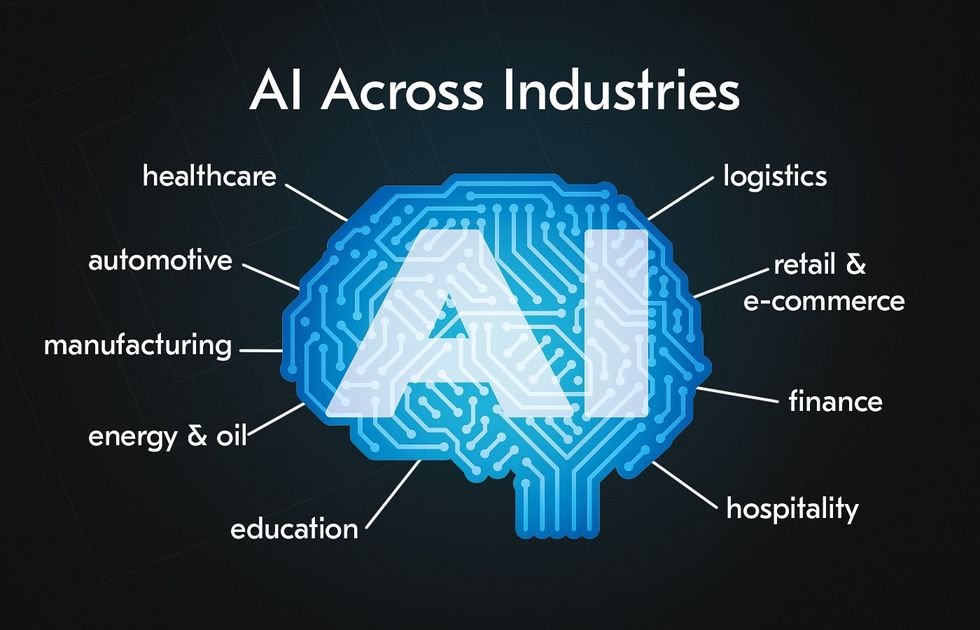
AI is now part of the daily business routine. From promotional messaging and image recognition to drug discovery and genomics, here are the most interesting applications of artificial intelligence for business productivity.
1. Customer Service & Support
AI chatbots and virtual assistants process millions of customer questions every day.
- Example: Sephora’s chatbot offers tailored beauty tips, decreasing reliance on call centers.
- Impact: According to Juniper Research, AI chatbots save a business over $8 billion per year in customer support costs.
2. Sales & Marketing Optimization
Businesses turn to AI for predicting customer intent, running targeted campaigns, and driving higher conversions.
- Example: Coca-Cola taps AI to track social media trends and launch campaigns with youthful appeal.
- Impact: Businesses that utilize AI-based marketing experience 20–30% stronger sales productivity (McKinsey).
3. Human Resources & Talent Management
Artificial intelligence also expedites the hiring process by scanning resumes, evaluating skill sets and even predicting cultural fit.
- Example: Unilever uses AI-backed video interviews to screen candidates and cuts time spent on hiring by 75%. It even creates meeting summaries and notes, making evaluations more efficient.
- Impact: Faster hiring processes and improved employee retention.
4. Supply Chain & Logistics
Artificial intelligence maximizes inventory, forecasts demand and reduces travel time.
- Example: Amazon uses artificial intelligence to predict customer demand and operate warehouses autonomously.
- Impact: AI-powered supply chains can cut costs up to 15% and reduce shipping times substantially.
5. Financial Services & Risk Management
Banks and fintech companies are using AI for fraud prevention, credit scoring and personal finance recommendations.
- Example: Mastercard uses its Decision Intelligence to process transactions in milliseconds to stop fraud.
- Impact: Artificial intelligence lowers banking sector fraud losses by 20-30% each year.
6. Product Development & Innovation
AI speeds R&D by analyzing vast data sets, running simulations and suggesting design options.
- Example: BMW uses AI to design more efficient car parts and virtually test prototypes.
- Impact: Shorter innovation cycles and 25% R&D cost reduction.
Case Study Highlight:
- Spotify uses AI to create hyper-personalized playlists for its 456M+ users around the world. This personalization is paying off, with 80% of streams now generated by AI recommendations.
Challenges and Risks of AI in Business
AI brings an enormous number of opportunities, but there are equally important challenges that come with adopting it that businesses have to navigate carefully.
Ignoring these dangers can compromise trust, escalate the cost and perhaps even cause harm to the brand.
1. Data Privacy & Security Concerns
This may also include private information about customers and employees. The consequences of any misuse or breach can be both regulatory punishment and trust damages.
- Example: In 2023, a top AI-powered chatbot for a finance firm mistakenly publicly exposed private customer information.
- Impact: IBM reports that the average cost of a data breach was $4.45 million in 2023, and AI-enabled leaks are only set to increase as dependence proliferates.
2. Ethical Dilemmas and Algorithmic Bias
AI models may unintentionally perpetuate bias if they are trained on imbalanced and incomplete data. This may result in biased hiring decisions, discriminatory credit scores or unfair legal judgments.
- Example: Amazon’s AI recruitment tool was scrapped after it was found to favor male candidates over female applicants.
- Impact: AI can also lead to legal liabilities, PR crises, and oversight by regulators.
3. Job Displacement vs. Job Transformation
Whether AI will replace human jobs or change them is one of the most hotly debated questions.
- Reality check: The World Economic Forum (WEF) says AI will lead to a loss of 85 million jobs by 2025, but will also create 97 million new jobs in data, AI operations and emerging tech.
- Impact: Repetitive positions (think call center operators and data entry clerks) are the ones on the line, while new openings are appearing around AI governance, training, monitoring, etc.
4. Over-Reliance on AI
Firms risk over-relying on AI systems to make critical decisions. If the models are unreliable, vulnerable to adversarial attacks, or output incorrect results, it can be a catastrophically bad move.
- Example: Some AI demand forecasting systems failed during the COVID-19 pandemic because they were not trained on any data related to that kind of outrageous event.
- Impact: Over-reliance on AI can result in strategic errors, financial setbacks and operational disruptions.
Mitigation Strategies for Businesses
To manage these risks effectively, businesses can adopt the following approaches:
- Strong Data Governance: Include strict GDPR, HIPAA, or local privacy law enforcement, encryption of data at rest, and real-time monitoring.
- Bias Auditing & Ethical AI: Regularly assess algorithms for bias, include diverse training data and conform to frameworks such as the EU AI Act or OECD AI Principles.
- Reskilling & Upskilling Workforce: Invest in lifelong learning, so employees can move from repetitive tasks into AI-managed, analytical, creative jobs.
- Human-in-the-Loop Systems: Keep human control in important AI decisions, to maintain accountability and allow for error correction.
- AI Risk Management Frameworks: Adopt guidance from institutions such as NIST (National Institute of Standards and Technology) for securing AI and assessing risk.
Case Study Highlight:
British Airways had a meltdown when its AI-generated rota system failed, and it had to cancel flights across the board.
The airline later switched to a human-in-the-loop process, in which AI makes the schedules but humans sign off on crucial decisions. This decreased errors by 32% in the following quarters.
How to Implement AI in Business for Productivity
Implementing AI isn’t simply a matter of buying the newest tools. Success requires a structured approach that lays a foundation for connecting technology to business goals, developing an AI-ready culture and effectively measuring results.
1. Assessing Needs & Setting Goals
Before adopting AI, businesses must define clear objectives.
- Ask: What problem are we solving? Is it reducing operational costs, automating repetitive work, or boosting customer engagement?
- Example: A logistics company discovered that delivery routes were costing them 12% of the revenue. After introducing AI-enabled route optimization, for instance, they reduced transportation costs by 8% in the first year.
- Tip: Use a “Pain Point Mapping” exercise, list your business challenges, rank them by cost/time impact, and target the opportunities with AI.
2. Choosing the Right AI Tools
The right tool can save you time and money. Some aspects that businesses should be analyzing AI solutions for include:
- Scalability (Can it grow with the company?)
- Integration (Does it work with existing systems like CRM, ERP, HRMS?)
- Cost-effectiveness (Is the ROI measurable within 12–18 months?)
Categories of AI tools:
- Customer Service: ChatGPT-powered chatbots, Zendesk AI
- Operations: UiPath (RPA), IBM Watson
- Sales & Marketing: Salesforce Einstein, HubSpot AI
- Data Analytics: Power BI with AI, Google BigQuery ML
Case Study: Shopify added AI-based personalization to its e-commerce offering. Retailers that have adopted the feature noticed 10 – 20% lift in conversion rates.
3. Building an Internal AI Culture
AI adoption is not just IT’s job, it’s an organizational shift.
- Encourage AI literacy across departments.
- Create cross-functional AI teams (tech + domain experts).
- Appoint AI champions within each department who guide adoption.
Example: Deloitte has internal “AI Labs,” where employees experiment with AI use cases. Such a bottom-up ramp saw adoption rates 30% faster than a top-down rollout.
4. Training Employees
AI works best when employees know how to leverage it effectively.
- Offer AI upskilling programs (Coursera, Udemy, LinkedIn Learning).
- Focus on collaboration skills: prompt engineering, data interpretation, and decision-making with AI assistance.
- Encourage a growth mindset: AI is not here to replace jobs but to enhance them.
Stat Insight: PwC reports 74% of workers are even willing to up-skill in new AI competency, if companies commit to up-skill training.
5. Measuring ROI from AI Investments
Failures of many business come from not logging AI impact. Measuring ROI is crucial.
Key Metrics:
- Productivity Gains: Time saved per employee
- Revenue Growth: Increase in sales due to personalization or forecasting
- Cost Reduction: Lower operational or labor costs
- Customer Experience: Higher Net Promoter Score (NPS), reduced response times
Case Study: A mid-sized insurance firm used AI-based insurance claims processing.
- Before AI: Claim settlement took 7–10 days.
- After AI: Settlements dropped to 24 hours.
- ROI: Saved $12 million annually in operational costs, with a payback period of just 9 months.
Future of AI in Business and Productivity
For business productivity, the days ahead will be all about AI growing beyond automation, to become intelligent, connected and trustworthy systems.
Here are some of the most significant AI trends we’re seeing that will define its future:
1. Hyperautomation
- Definition: Hyperautomation is the evolution of digital transformation where AI, RPA (Robotic Process Automation), and ML come together to not only automate simple tasks but whole workflows and decisions.
- Impact:
- Companies will reach full-stack automation across finance, human resources, supply chain and customer service.
- Minimizes risk of human errors, enhances productivity, and facilitates faster decisions.
- Example: Gartner predicts that by 2027, hyperautomation will reduce operational costs for enterprises by 30%.
- Future Outlook: Companies will move from isolated AI projects to organization-wide automation ecosystems.
2. AI + IoT + Blockchain Integration
It’s not an AI future, it’s a future of AI plus other more advanced technologies.
- AI + IoT (AIoT): Sensors, wearables, smart factories, these are all IoT devices that capture data, and AI is then used to process the data to give us real-time action.
- Example: Smart factories using AIoT predict machine failures and reduce downtime by up to 50%.
- AI + Blockchain: Blockchain guarantees the integrity of information, transparency, and trust; AI powers analysis and automation.
- Example: In supply chains, blockchain offers unalterable records of goods, while AI predicts demand trends to streamline shipping.
- Future Outlook: Look for “intelligent, connected and secure ecosystems” in which devices share information automatically and take real-time actions without human intervention.
3. The Role of Generative AI
Generative AI will grow from a content generator to a business strategy and innovation co-pilot.
- Applications:
- Product design & prototyping (AI can generate 3D models, designs, and simulations).
- Marketing (personalized ad creatives, dynamic campaigns).
- Software development (auto-generating code & testing).
- Legal documents (AI can draft contracts, agreements, and compliance paperwork, saving time and reducing human errors).
- Impact on Productivity:
- Accelerates innovation cycles.
- Cuts the costs of R&D and marketing.
- Enables businesses to enter markets faster.
- Example: Nvidia and BMW co-developed an AI-powered “digital twin factory,” saving 30% on product development time.
- Future Outlook: Generative AI will become decision-making assistants that can understand complex markets, anticipate customer desires and recommend strategic actions.
4. AI Governance & Regulations
With AI use rapidly increasing, governance and compliance will be increasingly important for maximizing productivity.
- Concerns: Data privacy, ethical AI use, bias in decision-making, and job displacement.
- Regulatory Developments:
- The AI Act of the EU seeks to categorize AI systems by risk and regulate them accordingly.
- India and the U.S. are preparing models for accountability and responsible deployment of AI.
- Business Implications:
- Companies will require AI governance teams to keep things in check and develop trust.
- Transparent and explainable AI will be a competitive advantage; companies that can demonstrate that their AI is fair and trustworthy will win over customers.
- Future Outlook: A new productivity stream that not only looks at speed and efficiency, but at trust, ethics, and sustainability in the context of AI-supported processes.
FAQs
AI increases productivity by automating mundane tasks, analyzing volumes of data for intelligence, improving decision-making, and facilitating better customer interactions. That makes it cheaper and allows employees to focus on more strategic roles.
Although just about every industry can benefit, the greatest ROI is realised in health care, finance, retail, manufacturing, logistics, and IT services, where automation and predictive analytics can help save valuable time and resources.
Not necessarily. There are many cloud-based AI offerings, from chatbots to CRM automation to predictive analytics platforms, that are inexpensive and scalable for small and medium-sized businesses. They can be tiny at the start and grow with time.
Businesses can calculate ROI by monitoring cost savings, time spent, revenue generated, customer satisfaction, and efficiency gains. Clear goal setting right before the adoption of AI is critical to measuring your ROI accurately.
Key challenges are privacy concerns around data, bias in AI algorithms, automation adoption, and regulation compliance. To address this risk, companies must deploy AI governance, along with employee training and ethics.
Where Do I Get These Information?
Here are the references I used to write this detailed article about how we can use AI in business and productivity, specially the case studies:
Conclusion
AI is no longer just a new tech; it makes businesses productive and successful today.
From automating mundane activities to unlocking insights and supporting hyper-personalized customer experiences, AI allows organizations of all sizes to do more, faster and with much greater efficiency.
Though there are challenges such as data privacy, bias and ethical use, companies leveraging AI prudently should be able to create lasting competitive advantages.
The convergence of AI with other technologies such as the IoT and blockchain, in combination with developments in generative AI, will transform industries in ways we’re just now beginning to understand.
So, that’s all I’ve for you in this article. I hope that this guide has helped you. For more info, comment below. Or if you have any complaint regarding the content we published, reach us out.
